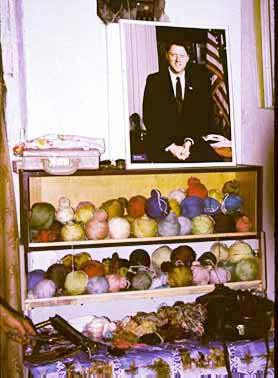|

Autumn 1997 (5.3)
Pages 74-77
State Visits,
State Gifts
Memorializing
the Clintons in Carpets
by Anne Kressler
Exactly what do kings and
queens, princes and presidents give one another to commemorate
the momentous occasions of their official visits. And what's
the perfect gift to offer someone who has access to everything
they could ever wish for? No doubt every Head of State faces
this dilemma many times during his tenure in office. Here's the
background to the gift that President Aliyev presented to Bill
Clinton on his visit to the White House on August 1, 1997.

The Carpet for Clintons and
the team which wove it. In Baku. 1997
Along with myriad details to
finalize in preparation of his first official visit to United
States, President Aliyev wanted to find a way to mark the momentous
occasion with a gift. It's not like on the way to the White House,
you casually ask your chauffeur to stop by a florist' stand and
pick up a dozen long-stemmed roses. President Aliyev wanted this
gift to be unique, distinguished from all other gifts in the
whole world. He wanted it to be aesthetically beautiful, something
representative of Azerbaijani arts and craftsmanship, and, in
typical Azerbaijani style, something very personal.
 |
 |
Aliyev's trip to the United States had long been anticipated
and, frankly speaking, was long overdue. Four years into his
presidency, he had signed more contracts with American oil companies
than with any other foreign country. The investment value ran
into billions of dollars. So he deserved acknowledgment, if only,
for these enormous economic ties that he has fostered between
the two countries. On his part, the Azerbaijan President openly
admits that relationships with the West, especially the United
States, are strategic in his quest to preserve the independence
of his own tiny country, which is no larger than the size of
Maine.
It seems the choice of Clinton's gift came long before Aliyev
received the formal official invitation to visit the White House.
The coveted letter of invitation came in late spring when the
U.S. Ambassador in Baku, Richard Kauzlarich, presented it to
him on the occasion of his 74th birthday-May 10th. The visit
was eventually fixed for August 1, giving the Azerbaijani government
merely ten weeks to organize the trip with a 60-member entourage.
The decision was finally made
to feature the portraits of both President Clinton and the First
Lady together in a handmade carpet. "I know how much a man
appreciates his wife and children," admitted Aliyev, himself
a widower since 1985 when his wife died of cancer. On earlier
occasions, he had met both Bill Clinton and his wife, Hillary,
a woman he found to be of great intelligence, highly articulate
and sympathetic, who has contributed enormously to her husband's
success as President.
Gathering Photos
In 1996, after Clinton's
second term in office was assured, President Aliyev approached
the renowned carpet portrait artist, Kamil Aliyev, 75, and commissioned
him to start thinking about a design featuring both the President
and First Lady together.
Kamil recalls how hesitant he was to tackle such a project. "I
had never seen two portraits featured on the same carpet,"
he said. "Usually one person is placed in the center of
a medallion or, occasionally, you'll find a group of people depicted
together but they're always treated as a single unit. I really
wasn't quite sure how to handle the symmetry with two portraits.
But I couldn't say no. How do you refuse the President on such
a momentous occasion?"
  So
Kamil went scouting for photos of the Clintons, inquiring at
the Embassy in Baku, and then at some of the American companies:
Did anyone have a photo or, perhaps, even a magazine that captured
the essence of this First Couple? Gradually, photos trickled
in. So
Kamil went scouting for photos of the Clintons, inquiring at
the Embassy in Baku, and then at some of the American companies:
Did anyone have a photo or, perhaps, even a magazine that captured
the essence of this First Couple? Gradually, photos trickled
in.
That's when the work began. "The whole process of carpet
design really begins with paper and pencil," explains Kamil.
He admits that the final sketch of the Clintons, whom he has
never seen, was a composite of numerous photos.
Since President Aliyev wanted to convey the unity of this couple,
Kamil decided to place them inside a stylized heart-shaped medallion.
Under their portraits is a vase of flowers. "I imagine their
life to be like a bouquet of flowers," he explained, thinking
of the prestige and glory of their position and not about the
tough opposition that the Clintons have received on a daily basis
ever since taking office. "I had heard a lot about this
couple and realized they were very close to each other. The world
knows that, too. I wanted to convey their lives as one beating
heart. I wanted them to be warm, charismatic portraits, not stiff
and formal," Kamil said, explaining the concept of his design.
Weaving
Though the concept for
the Clinton carpet started early, the actual task of weaving
it came only after Clinton's invitation. Therefore, it was an
extremely rushed job. The team had only ten weeks to complete
a work that normally would take four to five months, especially
since the facial details required precision down to the last
millimeter. Kamil himself was involved with dyeing the yarn in
80 to 90 different shades for the carpet which was 1.8 x 1.7
meters in dimension.
Twelve young women (ages 18-35) were employed in three 8-hour
shifts, working around the clock in a old workshop in the medieval
section of Baku called "Ichari Shahar"-Inner City.
An experienced master carpet weaver, Adiba Musayeva, was assigned
to weave all the facial details. When they reached that portion
of the carpet, she, alone, did all the work. Mass production
stopped until she managed to finish that section.
Mr. Clinton's suit is woven in dark blue and his wife's dress
is cardinal red with gold buttons. She wears a strand of twisted,
white miniature pearls, amazingly precise in detail. The background
pattern includes designs of golden browns and hues of red and
pastel blue. According to Kamil, some of the motifs are based
on the famous gigantic Shah Safi carpet (1539-1541) on display
at the Victoria and Albert Museum in London where it covers an
entire wall (10.97 x 5.37 meters). The Shah Safi carpet (or what
has become known as the Ardebil Carpet) is based on the Tabriz
school of carpet weaving, considered to be one of the finest
in the world.
Tabriz (a city in present-day Iran populated by Azerbaijanis)
became known as the first export center for Azerbaijani carpets.
As early as the 15th to 17th centuries, these carpets became
popular in Europe and were often used to decorate palaces. Portrait
paintings by famous European artists of that period often include
carpets on the floor with designs that are recognizably Azerbaijani.
Portrait carpets
Portrait carpets are
not new in Azerbaijan although sunbursts, dragons and other geometrical
or floral motifs are more common. It seems portraits started
becoming famous as State gifts in the USSR in the 1960s with
the artistic carpetry of Azerbaijani Latif Karimov (1906-1991).
Prior to that, portrait carpets had existed but were not highly
refined in design. Karimov designed portraits to commemorate
great poets of Eastern tradition such as Ferdowsi, Nizami, Nasimi,
Vagif and Samad Vurgun, along with the Russian writers Pushkin
and Gorky. Then there were the obvious state heroes like Lenin
and Gorbachev. Even Yuri Gagarin, the first Soviet cosmonaut
who circled the earth for the first time in a rocket in one hour,
29 minutes at 18,000 miles an hour in 1961 was memorialized in
a portrait carpet as was the first Soviet woman cosmonaut, Valentina
Tereshkova, after orbiting the earth 48 times in 71 hours in
1963.
Karimov who spent endless hours was fond of saying, "The
rugs and carpets I produce have thousands of knots! And each
single knot holds so much trouble, so much labor!"
Kamil's career in portrait carpets began in the 1960s. Since
then, he has designed numerous portrait carpets. For example,
Gorbachev took his Indira Gandi carpet to India where it is now
on display in the museum bearing her name.
Future Viewers
The day before the Azerbaijani
officials boarded the plane for the U.S., the Clinton carpet
was rolled up and presented to Aliyev. At the top edge of the
carpet woven in English is the inscription, "From the President
of Azerbaijan, Heydar Aliyev, on 1, 08, 97."
American presidents are not allowed to keep the endless array
of gifts they receive. They become property of the government
and, eventually, who knows where they end up. A century or two
from now, perhaps, someone, somewhere will pause in front of
this rare art piece, perhaps displayed in a museum some place,
and wonder about the political, economic and personal stories
behind this symbolic gesture from the tiny, energy-rich country
7,500 miles away, commemorating the leader of the world's gigantic
superpower at the turn of the 20th century.
From Azerbaijan International (5.3) Autumn 1997.
© Azerbaijan International 1997. All rights reserved.
Back to Index
AI 5.3 (Autumn 1997)
AI Home | Magazine
Choice
| Topics
| Store
| Contact
us
|




